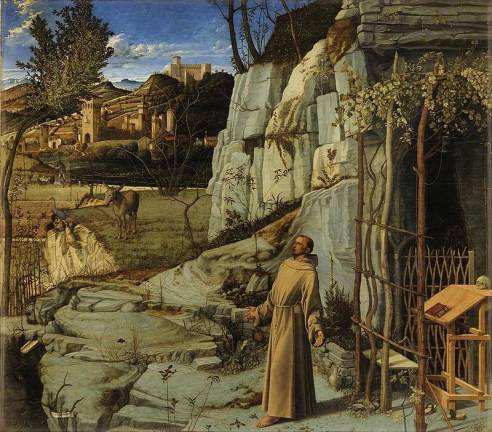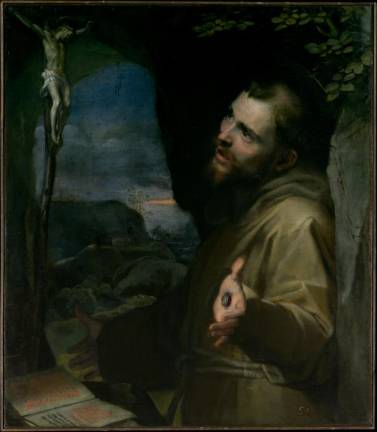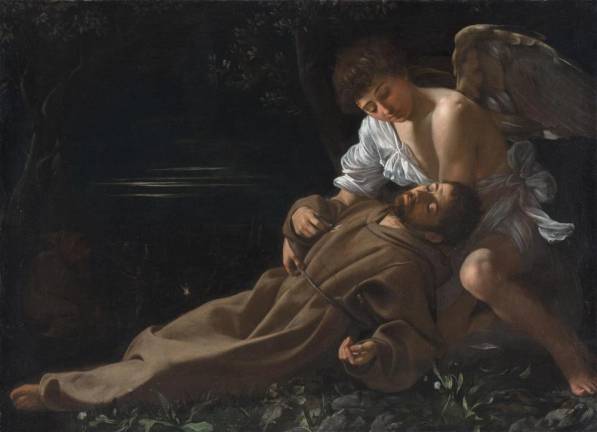Move over, Metropolitan Museum of Art: if you want to see what’s been called by many “the most important Renaissance painting in the US,” head for the Frick ... at least virtually. It was also the very first work chosen for the Frick’s Friday “Cocktails with a Curator” digital offering.
This is the esteemed masterpiece by Giovanni Bellini, “St. Francis in the Desert.”
The Frick’s collection is basically Western civilization’s greatest hits, but this work is first among equals, at least for me.
Who is that guy anyway?
St. Francis, the most famous of all saints, renounced a life of wealth and embraced poverty as a preacher and religious reformer. He was particularly devoted to animals and nature. (Churches still hold Blessing of the Animals ceremonies on October 4, his feast day.) Besides the miracles attributed to him, he was a mystic who often fell into ecstasies in which he was in direct contact with God. In one case, he was graced with the stigmata - the wounds suffered by Christ on the cross - nail marks on his palms and insteps, and a wound near his heart.
This event was a popular subject for art patrons and their artists. Caravaggio’s version in the Wadsworth Atheneum has a swooning St. Francis supported by a very hunky angel; the Metropolitan Museum of Art has a work by the Italian Baroque master, Barocci, that beautifully shows a man in reverent awe at the very moment of direct connection with God.
In most paintings, it’s all about Francis with little or nothing else in the painting. But not this one.
Bellini’s take
Giovanni Bellini (1430-1560) a noted Venetian artist, took a different approach. He sets the saint and the miracle amid the ordinary details of daily life, as if it were a genre painting of a 13th century hermit. The saint is standing outside his humble hut, in a rocky hillside beside a stream near a town. His robe is patched and he is barefoot. His arms are outstretched and his mouth is agape as he stares upwards, his back bent slightly backwards. A faint light from the upper left give scant illumination. The painting is rich in detail and soaked in vibrant colors in the landscape, the foliage and the wildlife.
What’s going on?
Some think he is singing his Canticle of the Sun as it rises. He is bent backwards, with arms outstretched like he’s Tony Bennett belting out the finale at the Palace. A closer look indicates otherwise.
This is a man suddenly and unexpectedly struck by the overwhelming call of the Divine. The force of the call takes him by surprise and pushes him backward. His mouth hangs open, his eyes are transfixed by something only suggested by the light from the upper left, reflected in the stone wall behind him. Even the tree in the upper left corner is bent by its force and power. He didn’t even have time to get his shoes or his walking stick.
This is a man in the throes of an extreme religious experience. Unlike other renderings, this St. Francis seems caught by surprise by the divine visitation, suggested only by the subtle cast of light from the upper left corner of the work as it filters through the tree and the landscape.
For all the invisible force, the call is subtle. One can barely see the faintest traces of the stigmata on his hands. And this divine call is for him alone. The donkey is contentedly chewing grass undisturbed; farther on, a shepherd is tending his flocks. They don’t hear or see a thing. Centuries later W.H. Auden wrote “Musée des Beaux Arts,” describing the nonchalance of the rest of the world while terrible things happened. Here is the opposite: in the midst of this sacred moment, life goes on.
And what a rich life it is. This may well be among the earliest examples of a genre painting, those works celebrating ordinary life so loved by the Northern Europeans centuries later. The detail of the background with the walled town, is true to life, as is the shepherd and his flocks. Each strand of ivy, each leaf and flower is lovingly detailed, right down to the rabbit hiding in his hole, the kitchen garden nearby with its water jug, the trickle of water from the funnel that brings him water from the stream behind him.
Bellini was a master of such painstaking detail thanks to his skill with oil paint, which allowed finer brush control and brilliant colors. A true Venetian painter, his canvas is soaked in shades of green, ochre and bursts of yellow. Bellini painted well into his 80’s, was hailed by Durer as a "master” and influenced Titian and Tintoretto. (And has a peach-infused Champagne cocktail named for him).
This work has pride of place in the drawing room of the Frick, between two Titians and across from an El Greco and two Holbeins. One can imagine Henry Clay sitting with a cigar and a glass of cognac contemplating this work. It’s odd to think that a ruthless businessman (there was even an assassination attempt) of unimaginable wealth ($40 billion in today’s dollars) would take such pride in a work honoring a man who rejected wealth to live in utter poverty to serve God.
For "Cocktails with a Curator," go to https://www.frick.org/interact/miniseries/cocktails_curator/cocktails_bellinis_st_francis_desert


